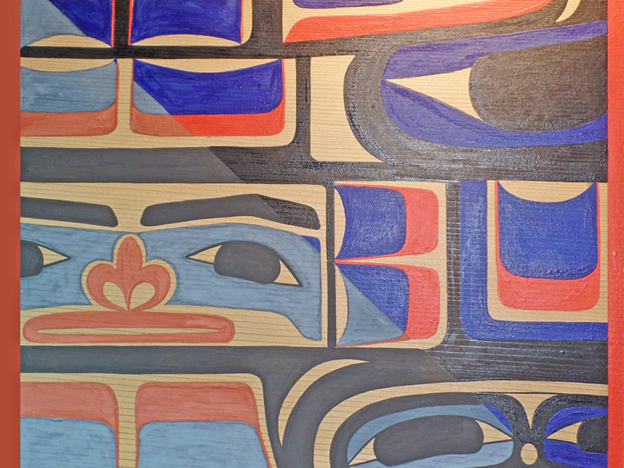
By Sam Gerrish
Kittredge Gallery is currently home to “In The Flow: Art, Ecology, and Pedagogy,” an exhibit which explores place-based ways of knowing in conversation with education, creativity, and climate change. The show is part of a greater symposium that has been in the making for two years. The event included a reception, poetry reading, panel discussion, and eight unique workshops which took place on Nov. 3 and 4.
The show features nine artists from the Salish Sea and the Columbia Basin, with several hailing from the Northwest Five Consortium. The University of Puget Sound is represented by “Seeding Lushootseed,” a piece displaying signage that was produced by the students in Professor Renee Simms and Professor Rachel DeMotts’ 2021 Environmental Racism course for their final project. These signs provide the Lushootseed names for a variety of plant species growing on the University’s campus, and can be found standing beside each of the plants that they describe.
“Seeding Lushootseed” was created in partnership with Christopher Briden of the Puyallup Tribal Language School. DeMotts and Simms were committed to prioritizing the wishes of their Indigenous community partners from the very start of the project through to its fruition. “As Prof. Simms and I were thinking about the work that we wanted to do in the class, we thought, you know, how do we emulate work that’s important to folks in the community already, rather than us sitting here in our ivory tower, thinking about what’s important, and independently: so how do we co-create something in a meaningful way?” DeMotts said.
Professor Elise Richman is one of the earliest members of the team behind “In The Flow” and an active working artist, but felt that “Seeding Lushootseed” was the piece to best represent our University. “I thought that Rachel and Renee’s project with their students was the best example of thinking about Indigenous knowledge, place-based knowledge, art, and ecology, better than anything I could have personally contributed, so I reached out to them, and they are the representatives of our institution,” Richman said.
Both DeMotts and Simms were panelists in the discussion on the symposium’s first day. DeMotts felt that they spoke much more about the collaborative process behind the signs and the importance of respect in their relationship with their community partners than about the signs themselves. “It requires a different way of thinking about what it means to work with someone. It’s not ‘just run out into the community and get what you want,’” she said.
DeMotts also spoke about the gallery, with many of its pieces being composed of materials not common in such a space, as an environment which helped invite important interdisciplinary conversation and interrogated traditional boundaries. “There are all sorts of different disciplines and perspectives implicated in and brought into the conversation in that space. And I think that’s really useful. One of the things that came up in the panel discussion was, one of the other panelists referred to what we were all kind of talking about, as work that was considered transgressive, right, crossing boundaries in ways that you don’t normally think about. And I think that’s really useful, actually,” she said.
Richman agreed with this sentiment. “That was an incredibly rich conversation about relationships between classification and language and place and displacement,” she said.
These conversations are an essential manifestation of the themes of “In The Flow,” one of which is the importance of the learning that can occur outside of traditional western institutions. As written in the gallery statement, “It matters who and what we listen to and in this moment, place and land are critical teachers. Pedagogy is not bound to institutions, it occurs in our communities, the natural world, through oral traditions and through other species. The artists in this show find teachers and collaborators among rocks, glaciers, earth, fungi, oceans, Nch’i-wana/Wimal/Columbia River, plants, other humans and pre-colonial languages of place.”
This sentiment is clear in the creative process behind “Seeding Lushootseed.” Working to translate between English and Lushootseed — in collaboration with the Puyallup Tribal Language School — demonstrated for the class the ability of Indigenous language to preserve environmental knowledge. “Names for plants will often mark their place in the ecosystem – when they bloom or when it’s okay to harvest from them, or those sorts of things. Names for animals might indicate a season in which something could be hunted. So a cedar, a Western Red Cedar, doesn’t translate to Western Red Cedar, it translates to something that tells you something about the relationship with that plant to where it lives. And so that makes the getting right of the translations that much more important,” DeMotts said.
